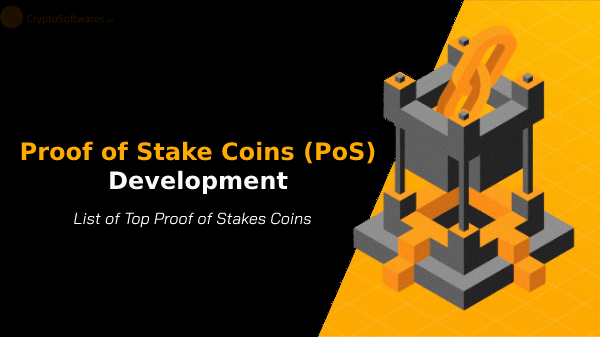
Proof of Stake Coins Development – A Complete Guide
SubscribeBlockchain has emerged as an innovative solution to many complicated business scenarios. Nowadays businesses and startups are developing their own CryptoCoins to keep up with the competition and explore the possibilities offered by this amazing technology. However, cryptocurrencies have been accused of excessive consumption of electricity and computation power for the mining process.
Proof of Work, the original consensus mechanism currently used in popular cryptos like bitcoin and ethereum is responsible for this high energy consumption. According to Cambridge research, bitcoin mining consumes about 121 Terawatt hours of power a year. That is more than the whole power consumption of countries like Argentina, Netherlands and UAE. If only there was a system as secure and less power consuming. This is what paved the way for the Proof of Stake system.
The Proof of Stake (PoS) system was introduced back in 2011 as an alternative to the Proof of Work system. Both are consensus mechanisms used in blockchain. While Proof of Work is notorious for its requirement for high computing power and massive power consumption, Proof of Stake offers a simpler alternative. Let’s dig into what Proof of Stake is, its features, how it fares against Proof of Work, top coins using Proof of Stake and Proof of Stake coin development and how to create a Proof of Stake Coins.
What is Proof of Stake?
Proof of stake is a procedure that aims to make the whole mining process virtual and replace miners with validators. In PoS, nodes stake an amount to become candidates to mine or validate a new block and earn a reward. Then, an algorithm chooses a validator from a pool of candidates. The chosen one will validate the new block. This choosing algorithm makes its selection based on the amount of cryptocurrency owned by the node with other factors to make a fair selection.
The chosen validator verifies the transactions and when the block is ‘OK’-ed, he/she gets repaid their stake and is rewarded on top of that. If the block is not ‘OK’-ed, the validator goes on to lose the stake he initially placed.
Read more on Proof of Stakes – A Complete Guide
Features of Proof of Stake Coins
- Finite number of coins in existence
- Transaction Fee as Reward
- Impracticality of the 51% attack
In a Proof of Stake based system, there will always be only a finite number of coins in existence. Whereas, new coins are brought into existence in order to reward miners in PoW systems.
Each transaction is charged a fee. This fee is given as reward to the validators. If the transaction turns out to be fraudulent, the validator doesn’t get their reward. Additionally the stake they placed on the block is also lost.
In order to conduct a 51% attack on a proof of stake based coin, the attackers would have to own 51% of the total coins in the network. This will be too expensive, and impractical.
Meanwhile discover the top ten Proof of stake coins that are in the crypto market today!
Proof of Stake vs Proof of Work – A Comparison
In a Proof of Work blockchain, to add each block to the chain, miners must compete to solve a difficult puzzle using their computing power. Whereas in Proof of Stake based blockchains, there is no competition as the block creator is chosen impartially by an algorithm based on the number of coins they own.
To add a malicious block, in a Proof of Work blockchain you would need to have more computing power than 51% of the network. In case of a Proof of Stake blockchain, adding a malicious block would require you to own at least 51% of all the cryptocurrency on the network.
In Proof of Work, the first miner to solve the puzzle gets rewarded. In Proof of Stake based systems there are no rewards so the block creator takes a transaction fee.
How does Proof Of Stake Algorithm Work?
Proof of Stake algorithm is a widely used term in the Cryptocurrency circle and has been making waves already. Why is the concept gaining strength over POW?
To initiate a transaction, the data is first embedded into a block and then duplicated across all the nodes that a part of the network. These nodes act as the admin and validates each transaction in the block. In order to do so, the miners will have to solve complex computational equations and the first miner to solve the block gets the mined coin.
The verified blocks become a part of the blockchain, which is a public transparent ledger. This is called the Proof of Work.
Advantages of POS Algorithm
1. As pointed earlier in the article, the POW based mining activities require a lot of energy and high-performance computers. Adopting POS can cut down the energy cost to considerable amounts. Hence, POS coins mined in this manner are way more energy efficient than coins that are based on Proof of Work algorithms.
2. In POW based mining, the miners don’t own the coins and look for maximizing their profits. Under POS, those guarding the coins will always own the coin.
List of Best Staking Coins 2021 ( Updated List )

Tezos (XTZ)
Tezos is a constantly evolving and upgrading crypto platform for apps and assets. It uses a consensus mechanism known as proof of liquid stake or Liquid POS. It is called so because your balance is not locked and can be transferred at any time.
Neo (NEO)
Neo is the Chinese version of Ethereum. It is a platform for new dApps, services and a launchpad for new tokens. It had a huge opening when it was launched in 2017, but has struggled slightly since.
Cosmos (ATOM)
Cosmos is a blockchain platform where startups can easily create their own blockchain services. They call themselves the internet of blockchains. Their aim is to bridge the gap between different blockchains and make their collaboration and coexisting easier.
Lisk (LSK)
Lisk is an open-source system aiming to make it easier for anyone to create their own blockchain. It’s software development kit is written in JavaScript. That makes it easier for new developers.
Algorand (ALGO)
Algorand is a blockchain known for its use of Pure PoS. Here the users are selected truly randomly for block validation. Founded in 2019, it is a secure and scalable blockchain free of potential governance issues.
Chromia (CHR)
Chromia is a blockchain focusing on solving the scalability problem for dApps. Its primary aim is to facilitate the generation of dApps. It is currently used in healthcare, finance and gaming.
PoS Coins Development- How To Create a Proof of Stake Coins?
Though it is a relatively new system, Proof of Stake has found plenty of suitors. There are over a hundred different Proof of Stake coins in the cryptocurrency market today. And they all add up to a market cap of over $140 billion. With Ethereum, the second most popular cryptocurrency in the world set to make the move from Proof of Work to Proof of Stake there is no doubt that these numbers will be on the rise.
If you want to take the unbeaten track, you can opt for customized Cryptocurrency development to get your own POS coins and market them.
Get the complete Guide on Security Token Offerings(STO)
- What is Cryptojacking? Detection and Preventions Techniques
- How to Give Cryptocurrency As a Gift?
- Blockchain Development Life Cycle – Step by Step Guide
- How To Hire A Blockchain Developer For Your Company
- How to Choose the Right Bitcoin Development Company – A Complete Guide
- Common Bitcoin Scams – Beware Of Fraudsters
- How can entrepreneurs leverage blockchain in 2023?
- Role of Blockchain in Cyber Security
- Document and Certificate Verification Through Blockchain Technology
- Initial Coin Offering (ICO): Everything you need to know in 2023
- Categories
- Azure Blockchain Service
- Bitcoin
- Bitcoin Development
- Blockchain Application
- Blockchain Application Development
- blockchain developer
- Blockchain Development
- common bitcoin scams
- Crypto software features
- Crypto softwares
- Cryptocurrency
- Cryptocurrency Development
- Cryptocurrency Exchange Software Development
- Cryptocurrency review
- Cryptocurrency Trading
- Cryptocurrency Wallet Development
- ERC20 Token Development
- Hashing Algorithm
- ICO Development
- ICO Development Service
- ico website development
- Proof of Stake Coins
- Smart Contract Development
- Uncategorized













Leave a Reply